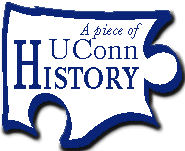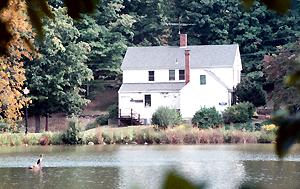This is an archived article. For the latest news, go to the Advance Homepage. For more archives, go to the Advance Archive/Search Page  | |||
|
Whitney's ties to UConn extend throughout Storrs campus
Last week's article described the history of Old Whitney Hall, the first campus building, and the stone step that marks where it was located. This week the Advance looks at more connections between the Whitney family and UConn. There are two places on the Storrs campus which carry the name Whitney - the dormitory in East Campus on Route 195, and the road between Arjona and Monteith buildings along Mirror Lake. But there is more here to remind us of the Whitneys' role in the history of the University of Connecticut. Edwin Whitney, whose home for orphans of the Civil War became the first campus building, died suddenly near the end of 1867, just a few months before his wife, Minerva Barrows Whitney, gave birth in the family house to a daughter, on Feb. 26, 1868. The daughter, named Edwina for her father, was to have a long career at Connecticut Agricultural College, serving as college librarian from 1900 to 1934.
Schooled at Oberlin College in Ohio, Edwina taught at Milwaukee College in Wisconsin for a year after graduation in 1894. Then, returning home because her mother was ill, she taught for four years at Windsor High School. At age 32, she took the job of librarian at Connecticut Agricultural College, which just the year before - in 1899 - had changed its name from Storrs Agricultural College. Besides her role as librarian, Edwina sold books and supplies to faculty and students. She also taught an introductory course in German, and later taught both beginning and advanced German. When she began work at the college in 1900, the campus library of 8,000 volumes - its reading room, stacks and periodicals, plus the bookstore - were run out of two small rooms in Old Whitney Hall. At the time, kerosene lamps were the source of light for the library; Edwina later noted in the diary she kept from 1918 to 1951 that the "installation of electric lights in 1907 was a great improvement." Her voluminous diaries are filled with observations, comments, opinions and insights about the campus and Storrs communities, and also offer a glimpse of her personality. Regarding faculty meetings, for example, in 1910 - after attending the third such meeting of the year - she wrote: "I hate them but they are necessary." In 1930, she had this observation: "Fac. Meet. mostly about nothing." And in 1924, she disclosed her political views, noting how she had just voted for Sen. Hiram Bingham: "I finally voted for Bingham. He is an enemy of the college and will be out of the way in Washington." After several years of disputes with the administration of the college, Edwina agreed to retire at the end of the spring semester in 1934 - the year the college became known as Connecticut State College. The May 29 issue of the student newspaper, The Connecticut Campus, was devoted to her career and retirement, and she was awarded an honorary degree at Commencement. She also was given the status of Librarian Emeritus, and faculty voted that her portrait be hung in the campus library. The 1938 Nutmeg yearbook was dedicated to Edwina, and in 1939, a new dormitory for women was named in her honor. She was noted as "a keeper of local knowledge and legends as well as a historian." She died on September 3, 1970, at the age of 102. The home in which Edwina was born is still a campus landmark. Having served as the post office for a time, when Edwina's mother was the postmistress, the house next to Mirror Lake, facing Route 195, is now part of the Division of International Affairs. For decades, it has been known as the International House, a gathering place for students from all nations. Behind the house, across the small lake and stretching up to Hillside Road, bisecting the 25-acre section of campus that once was the Whitney homestead, is Whitney Road. Mark J. Roy Sources: Three Storrs Pioneers, James H. Barnett, 1981; Connecticut Agricultural College - A History, Walter Stemmons, 1931; unpublished manuscript, Evan Hill, 1980. |


